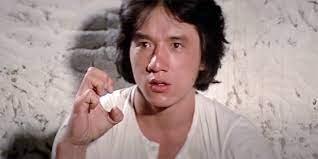SNAKE IN THE EAGLE'S SHADOW: Twist, Roll, Spin, Turn

Jackie Chan in Snake in the Eagle's Shadow
These notes on Snake in the Eagle's Shadow were written by Mattie Jacobs, graduate student in UW Madison's Department of Communication Arts. A 35mm print of Snake in the Eagle's Shadow will screen at the Cinematheque's regular venue, 4070 Vilas Hall, 821 University Ave, on Saturday, March 5, at 4 p.m., part of our weekend of screenings celebrating the release of the book These Fists Break Bricks!. Authors Chris Poggiali and Grady Hendrix will be in attendance! Admission is Free!
By Mattie Jacobs
Sixteen years after his first role as a child actor, and in his sixth film as a leading man, Jackie Chan became a breakout international star with Snake in the Eagle’s Shadow (1978). A decade of stunt work and action choreography, persistent roles as either a martial arts student or second-string thug, and an attempt to become the next Bruce Lee in New Fists of Fury (1976, where Chan first took his Chinese stage name: Sing Lung) all eventually led to Eagle’s Shadow. Shadow is a model for what would become the quintessential Jackie Chan film, an action- comedy that blends elaborate stunts and slapstick, always relying on both Jackie’s wit and his ability to take untold amounts of physical abuse - from teachers and enemies alike.
Eagle’s Shadow still manages to feel fresh with a plot structure that’s been copied so often it barely needs explanation: a good-hearted young student, a hidden martial arts master, and a showdown of one kung fu style versus another. This recipe would lead to a string of successful movies for Chan, including both Drunken Master and Spiritual Kung Fu later that same year. Here, Chan plays the fresh-faced and somewhat dimwitted Chien Fu, an orphan janitor in a martial arts school who is often used as a punching bag for the training students and loafing teachers. The bulk of the narrative follows his friendship with and training by a wandering beggar, the last of the remaining practitioners of the “Snake Kung Fu,” being hunted down by the Eagle Claw school. All of Chan’s charm is on display in his hapless attempts to make right and learn to defend himself from a world of be-moled minor villains (you’ll understand when you see it).
In addition to launching Chan’s career as a star, the film is also the directorial debut of Yuen Woo-ping, who would become the most famous martial arts choreographer in the world over his long career. After working with the likes of Chan, Sammo Hung, Donnie Yen, and Jet Li during his decades in Hong Kong, Yuen was asked by the Wachowskis to work on The Matrix in 1999, propelling his career into Hollywood. His touch as a choreographer is everywhere in Snake in the Eagle’s Shadow, designing the animal forms of Snake and Eagle kung fu to look completely different than the standard, traditional, martial arts forms used in Hong Kong films up to that point, or as he said in an interview with the SCMP,” it was all different shapes, it was like a whole new different style of kung fu.”
The forms are brilliantly elaborated throughout, with the movements of the snake form detailed as Chan trains and fights. From “poisonous snake” to “finding the snake” (the latter will be painful for some to watch), the forms feel both fleshed out and appropriately ridiculous, with Chan’s snake hand movements always precise. The strangest part of the film, the “cat’s claw” form that eventually defeats the other two forms, is born out of a short segment of a cat fighting a cobra to the death as the young, recently defeated, fighter looks on to find inspiration. It’s a disturbing bit of animal acting, with a hissing soundtrack to match.
Even as a debut film from a director, Snake in the Eagle’s Shadow feels like it knows what it’s doing right from the start. Each sequence is planned out to perfection, with many of the standards of the kung fu comedy film seeing some of their first iterations here, including Chan’s quasi-absurdist training montages - fingertip push-ups over a bed of burning incense and backbends on a set of poles. Yuen Woo-ping also experiments with new camera angles and movements throughout, attempting to better highlight both the fight acrobatics and Chan’s ability to hold an assortment of exaggerated pained expressions from each hit. Each blow is emphasized not just with sound effects, but with inserts of the damaged body parts (generally feet) and pauses for Jackie to moan and quickly recover - or not recover, as his autobiography recounts losing a tooth during filming from a kick to the face.
The last of its many highlights is the third person to achieve fame from the film, Yuen Siu-tien, in the role of the teacher-in-hiding. The actor is also the director’s father, and had been a Hong Kong cinema stalwart for decades; he’s better known now by the name of his famous role from Drunken Master (1978), Beggar So - and, for Wu-Tang reasons, even better known for his final role, as Ol’ Dirty. In Eagle’s Shadow, Yuen Siu-tien’s character Pai Chang-tien is functionally the “Beggar So” character that he would become known for: a kung fu master in hiding, mischievous, secretly warm-hearted, and a relentless taskmaster. Jackie Chan and Yuen Siu- tien together make Eagle’s Shadow something to remember with their screen chemistry, which feels like a combination of father and son, teacher and student, and as Pai maintains, friends - even as he whacks Chien Fu with his smoldering pipe all in the name of the Snake Kung Fu.
